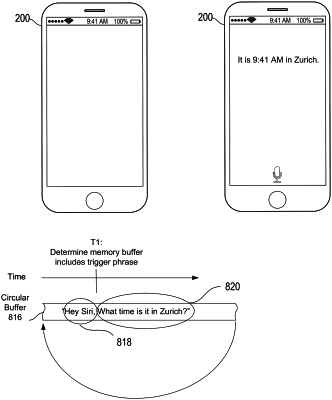| CPC G06F 3/167 (2013.01) [G06F 3/038 (2013.01); G06F 3/0481 (2013.01); G06F 3/0604 (2013.01); G06F 3/0656 (2013.01); G06F 3/0673 (2013.01); G10L 15/22 (2013.01); G10L 15/32 (2013.01); G10L 2015/088 (2013.01); G10L 2015/223 (2013.01); G10L 15/285 (2013.01); H04M 2201/40 (2013.01); H04M 2250/74 (2013.01)] | 39 Claims |

|
1. A non-transitory computer-readable storage medium storing one or more programs, the one or more programs comprising instructions, which when executed by one or more processors of an electronic device with a microphone, cause the device to:
while a main processor is in a low-power mode:
capture audio input from the microphone;
write, using a low-power processor, the captured audio input to a memory buffer; and
determine, using the low-power processor, whether the buffered audio input satisfies a set of criteria, wherein determining whether the buffered audio input satisfies the set of criteria includes:
determining whether a first portion of the buffered audio input includes a trigger phrase, wherein a first criterion of the set of criteria is satisfied when the first portion of the buffered audio input includes the trigger phrase; and
determining, by comparing speech characteristics of the buffered audio input to a set of known characteristics for an authorized user, whether the trigger phrase was spoken by the authorized user, wherein a second criterion of the set of criteria is satisfied when the first portion of the buffered audio input is spoken by the authorized user; and
in accordance with a determination that the buffered audio input satisfies the set of criteria:
cause the main processor to exit the low-power mode; and
after causing the main processor to exit the low-power mode:
identify, using the main processor, a computing task based on a second portion of the buffered audio input; and
execute, using the main processor, the identified computing task; and
in accordance with a determination that the buffered audio input does not satisfy the set of criteria, forgo causing the main processor to exit the low-power mode, identifying the computing task, and executing the computing task.
|